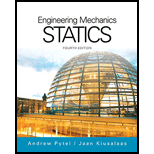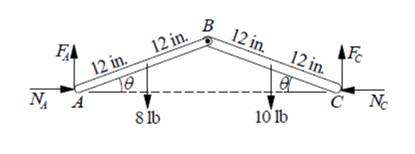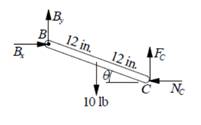
Concept explainers
The two homogeneous bars AB and BC are connected with a pin at B and placed between rough vertical walls. If the coefficient of static friction between each bar and the wall is 0.25, determine the largest angle 6 for which the assembly will remain at rest.

Largest angle θ for which the assembly will remain at rest
Answer to Problem 7.4P
The largest angle θ is equal to 6.75°.
Explanation of Solution
Given information:

Co-efficient of static friction between each bar and wall is 0.25.
For impending sliding, the friction force equals its limiting value;
F=Fmax=μsN
μs - Co-efficient of static friction
Steps to follow in the equilibrium analysis of a body are:
1. Draw the free body diagram.
2. Write the equilibrium equations.
3. Solve the equations for the unknowns.
Calculation:
FBD of assembly

Assume NA,NC as the reaction force at point A and C.
Assume FA,FC as the friction force at point A and C.
For the equilibrium of entire section, the bending moment about point A is equal to zero.
∑MA=0
FC((48 in)cosθ)−(8 lb)((12 in)cosθ)−(10 lb)((36 in)cosθ)=0
Solve
48FC−96−360=0 FC=9.5 lb
Write equilibrium equation in vertical direction.
↑∑Fy=0
FA+FC−(8 lb)−(10 lb)=0 FA=8.5 lb
Write equilibrium equation in horizontal direction.
→∑Fx=0
NA−NC=0 NA=NC
The impending sliding will first occur at point C.
FCNC>FANA
The reaction force NC at point C
NC=FC0.25 =9.5 lb0.25 =38 lb
FBD of bar BC

For the equilibrium of above section, the bending moment about point B is equal to zero.
∑MB=0
FC((24 in)cosθ)−NC((24 in)sinθ)−(10 lb)((12 in)cosθ)=0 9.5(24cosθ)−38(24sinθ)−10(12cosθ)=0 108cosθ−912sinθ=0
Therefore
θ=tan−1(108912) =6.75°
Conclusion:
The largest angle θ is equal to 6.75°.
Want to see more full solutions like this?
Chapter 7 Solutions
International Edition---engineering Mechanics: Statics, 4th Edition
- (◉ Home - my.uah.edu Homework#5 MasteringEngineering Mastering X + 8 https://session.engineering-mastering.pearson.com/myct/itemView?offset=next&assignmentProblemID=18992146arrow_forward(read image)arrow_forward(◉ Home - my.uah.edu Homework#5 MasteringEngineering Mastering X + 8 https://session.engineering-mastering.pearson.com/myct/itemView?assignmentProblemID=18992147&offset=nextarrow_forward
- (◉ Home - my.uah.edu Homework#5 MasteringEngineering Mastering X + 8 https://session.engineering-mastering.pearson.com/myct/itemView?assignmentProblemID=18992144&offset=nextarrow_forwardCalculate the forces in members BC, BG & FG of the truss shown using the Method of Sections. For your answer, provide atruss diagram of the calculated member forces and indicate whether the member is in Tension (+) or Compression (-)arrow_forwardSelect the speed, feed and depth of the cut to turn wrought, low carbon steel (hardness of 200 BHN) on lathe with AISI tool material of HSS M2 or M3. (Hint: refer to Chapter 21 for recommended parameters).arrow_forward
 International Edition---engineering Mechanics: St...Mechanical EngineeringISBN:9781305501607Author:Andrew Pytel And Jaan KiusalaasPublisher:CENGAGE L
International Edition---engineering Mechanics: St...Mechanical EngineeringISBN:9781305501607Author:Andrew Pytel And Jaan KiusalaasPublisher:CENGAGE L
